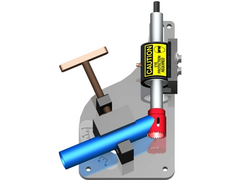Given that I've never yet even touched a MIG welder, I think I'll go with RHS. For the first one, anyway


I live in a second-storey flat, so I'm regrettably not in a position to build a Locost until I move home, hopefully in a year or two. So I'm
using the time to try & learn as much as I can before I start building.
So, first question: The book, and all the Locost builds I've come across so far, make the chassis out of RHS. But I was under the impression that
round tubes were better for spaceframes.
Is RHS used just because it's easier, or are there other important reasons too?
quote:
Originally posted by oneandoneis2
Is RHS used just because it's easier, or are there other important reasons too?
Follow this link
http://gtslocost.locostsites.co.uk/downloads.htm
And thank Flak Monkey for the info.
And welcome.
Round tubes are lighter / stronger (or a bit of both) than square tubes. Square tubes are easier to cut and easier to weld. The choice is down to
whether you want it easier to make or better to drive. It may be better to complete a RHS frame than fail to complete a round tube frame
MNR recently dropped their RHS chassis in favour of all round tube after buying a tube bending machine. It allows them fewer cuts and fewer welds per
chassis. They also have a fishmouth grinder too.
hole saw + pillar drill = cheap tube notcher. It's really not much harder to make. tis a pain mounting things to tube though
James
You also need to be more accurate when drilling / rivetting floor on.
As mm each way makes life very dificult.
regards
Agriv8
Thanks for all the replies. It's as I thought, then: Technically better, but practically much harder.
Given that I've never yet even touched a MIG welder, I think I'll go with RHS. For the first one, anyway 
I'd disagree....I've built many of both types.....and say "practically, a little harder"....although when it comes to compound
angles round wins easy over square....
Also I'd recommend square tube rather than RHS...RHS wall thickness's are generally too thick
quote:
Originally posted by Agriv8
You also need to be more accurate when drilling / rivetting floor on.
As mm each way makes life very dificult.
regards
Agriv8
I try and avoid drilling tube if I can....when using round I'll usually weld tabs on for attachments.....
Extra work and a pain...yes...but it looks great IMO
A few tabs can be seen on this.....

[Edited on 1/11/06 by Alan B]
Oooo, pretty 
Maybe I'll just try out a few bits of both round & square tubing before I start building and see what I make of them both.
I'd prefer round, just so long as it won't cause any major problems. .
Wish i had thought more about this before I started. I thought square tube would be generally easier to do, In retrospect the compound angles are a
real pain and fishmouthing with a pillar drill and hole saw is a lot easier than it sounds.
I will deffinitely try round tube for the next build!
Caber
quote:
Originally posted by caber
Wish i had thought more about this before I started. I thought square tube would be generally easier to do, In retrospect the compound angles are a real pain and fishmouthing with a pillar drill and hole saw is a lot easier than it sounds.
I will deffinitely try round tube for the next build!
Caber
I purchased one of these from the States, only $199, about £100, not too dear for a tool. It does do fantastic joints and the cutters are cheap.
It's a HSN 500 notcher, from a company called protool or something like it.


Rescued attachment hsn500-full.jpeg
Yup...that's the one I have too....works very well.......Protool do some good stuff, I got my bender off them too.....
I need convincing that 25mm round is stronger than square in the same gauge............especially where torsional rigidity is concerned.
Alex
quote:
Originally posted by lexi
I need convincing that 25mm round is stronger than square in the same gauge............especially where torsional rigidity is concerned.
Search for old posts.
I posted a load of maths about 7 or 8 months back with all the comparisons in, and have done on occasions before this too. I cant be arsed to do the
maths again!
David
From what my old man said, the best rule of thumb is take any given tube, dip it in fairy liquid and blow a half bubble out the end. The steepness of
the wall of the bubble is proportional to the addition that part of the tube wall adds to the stiffness of the member.
Or something like that. Bloody engineers.
I do remember the bit I was supposed to take away though - round's stiffer torsionally than square or rectangular tube.